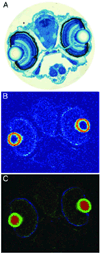In situ imaging of metals in cells and tissues
- PMID: 19772288
- PMCID: PMC3812694
- DOI: 10.1021/cr900223a
In situ imaging of metals in cells and tissues
Figures



















References
-
- Li YF, Chen CY, Qu Y, Gao YX, Li B, Zhao YL, Chai ZF. Pure Appl. Chem. 2008;80:2577.
-
- Ascone I, Strange R. J. Synchrot. Radiat. 2009;16:413. - PubMed
-
- Finney LA, O’Halloran TV. Science. 2003;300:931. - PubMed
-
- Bush AI. Curr. Opin. Chem. Biol. 2000;4:184. - PubMed
-
- Perls M. Virchows Arch. Pathol. Anat. 1867;39:42.
Publication types
MeSH terms
Substances
Grants and funding
LinkOut - more resources
Full Text Sources
Other Literature Sources

